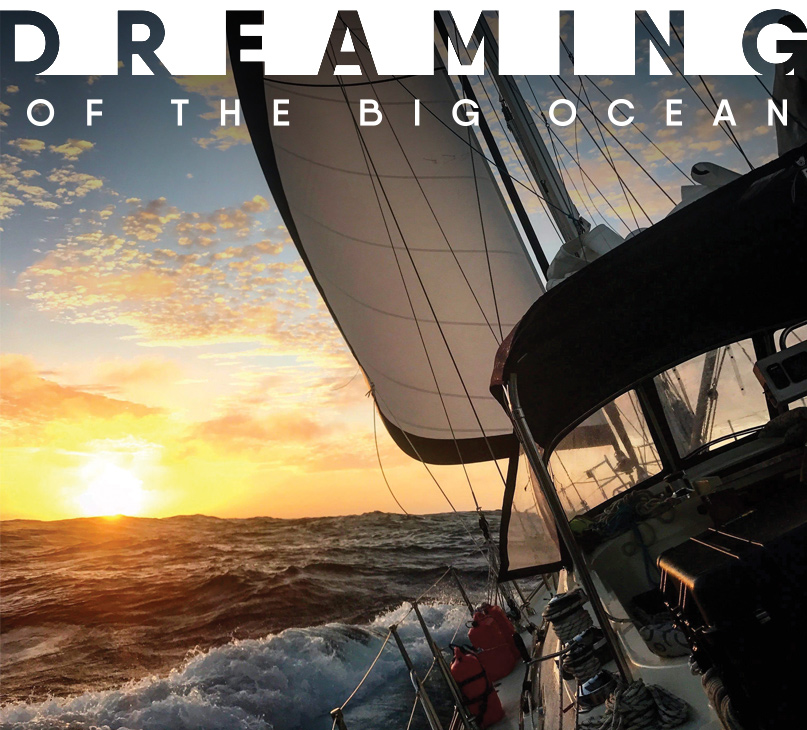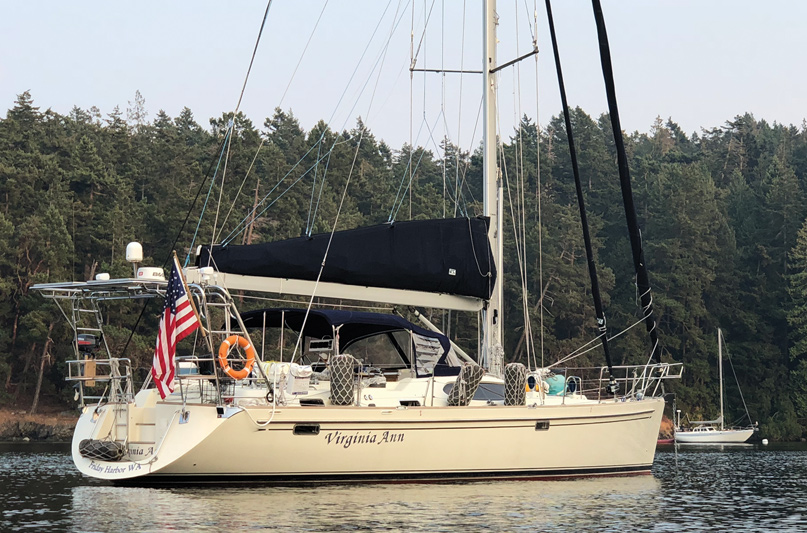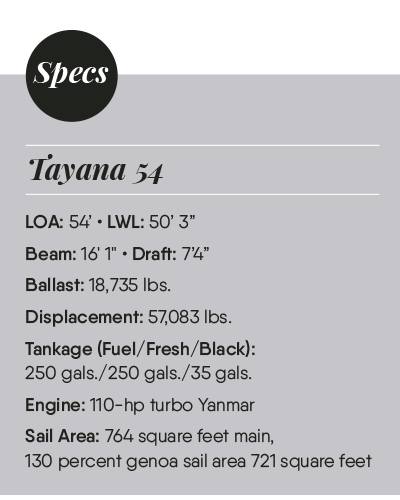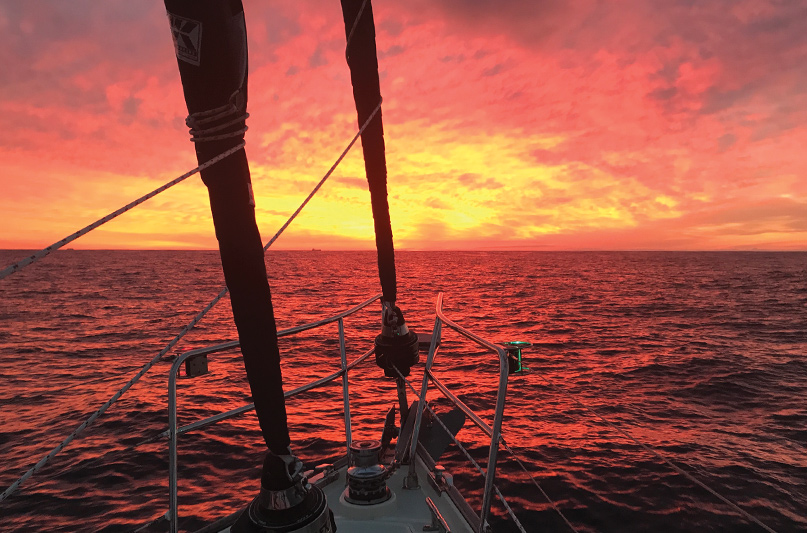
 While contemplating how I got here with my girlfriend Pamela Gingras and my best friend John Tanaka onboard, I realized how quickly life can turn on a dime. Virginia Ann, our new Tayana 54, was performing as expected. She was making 7 knots upwind, slicing through moderate seas with neutral helm and feeling solid.
While contemplating how I got here with my girlfriend Pamela Gingras and my best friend John Tanaka onboard, I realized how quickly life can turn on a dime. Virginia Ann, our new Tayana 54, was performing as expected. She was making 7 knots upwind, slicing through moderate seas with neutral helm and feeling solid.
It was only 12 hours since we received our departure paperwork from Taiwan customs and said goodbye to our new friends at Tayana Yachts.
The only excitement thus far was a blown jib sheet, quickly remedied by running a new sheet. It was the first test of the crew and although we had room for improvement, we had at least ten more days to hone our skills. Given this was her maiden voyage, we would all learn the nuances of the cutter-rigged Tayana 54 by trial and error.
The crew consisted of myself, Pamela, and John; the crew of Paul Michael, Rich Jones, and Ryan White; and our hired delivery captain Richard Bard.
John Tanaka and I met in grade school and would spend time sketching sailboats on our desks, daydreaming about sailing at the obvious displeasure of our teachers.
I would later read the National Geographic article about Robin Lee Graham and his book The Boy That Sailed The World Alone, which gave me inspiration that one day I, too, would be sailing the world. Flash forward several decades, and adulthood found me newly single and winding down my career, but with the boyhood dream still alive. Perhaps my book would be The Old Single Guy That Sailed The World Alone.
I had met Pamela at a dinner party where I discovered she had 25 years of boating experience cruising the Northwest and lived aboard a 50-foot ketch in Seattle. On top of that, she held a captain’s license. We began dating within a week.

With her competitive spirit, I introduced Pamela to racing for the first time on my Melges 24, where she excelled. Our first time together on her boat, I couldn’t locate her and yelled out “Where are you?” and got a quick reply back, “I’m in the engine room checking the fluids!”
It was instant boater love. She shared my dream of extensive world cruising, and after our first year together, we decided it was time to turn our dream into reality.
We went all over the world from Spain to Hong Kong, traveled across the U.S., and scoured the web in search for The Boat. Pamela finally talked me out of teak decks and a blue hull, reminding me that maintenance was costly and tropic temperatures lead to hot decks and a hot boat.
We also made a list of non-negotiable items, everything from performance to the size of the shower stalls. Little discussion was made as to how we would get a boat from a foreign country back to Seattle, as finding the right boat was priority one.
Then it happened; we found a nearly completed boat sitting on the hard at the Ta Yang boat yard in Kaohsiung, Taiwan, with no teak decks and a beautiful off-white hull. She was a Tayana 54 designed by my favorite naval architect, Bill Dixon. She had three cabins, two heads, a very large main salon and cockpit, as well as a walk-around bed in the aft master stateroom, a dream come true for Pamela.
Tayana translates to “Big Ocean” in Mandarin, now all that was needed was the “Big Dream.”
During our flight over to Taiwan, we both stated several times “I sure hope we hate this boat.” Exhausted from our travels, we still elected to go straight to the yard upon arrival.. We crawled all over her for several hours, barely speaking a word to each other, finally returning to our hotel. We closed the door, looked at each other, and shouted in unison several expletives that would make any sailor proud. We had found our perfect boat.
We began what would be a three-month project dedicated to purchasing her and getting her back to Seattle. We heard several horror stories about shipping companies—everything from sudden bankruptcies to a boat falling off the deck in a typhoon. We decided to sail her back with a delivery captain and crew, and with us on board for the first leg of the journey.
Pamela organized the logistics as I tended to my day job. We prioritized tasks as we had a tight window and needed to leave Taiwan no later than June 15 to beat the typhoon season. My work schedule would only allow me to be onboard for the first leg of the trip, so a search for a captain and crew was on.
Richard Bard from Vashon Island answered our listing on crewfinder.com. We met him over lunch and liked what he had to say. The safety of the crew and boat was his number one priority and the schedule would be determined by the weather conditions. We left it up to Richard to pick the other four crewmembers he wanted on board for the long north Pacific crossing.
A safety gear and a spare parts list (mostly filters and pumps) was put together over lunch with Richard and Paul Michael, his first pick to join the crew. The safety gear list included a drogue system, dry suits, EPIRB, life jackets, safety harnesses, strobe lights, jack lines, man overboard pole and retrieval system, life sling, and an eight-man life raft already on the boat.
Communication and nav equipment included two chartplotters with AIS, Iridium Go satellite system, Inmarsat satellite phone, SSB with GAM antennae, and KISS grounding plane, weather fax, and three VHF radios.
Everything would need to be shipped via FedEx or packed into checked luggage. Virtually all necessary sailboat hardware needs to be imported into Taiwan. Pamela, John, and I flew to Taiwan loaded to the gills with gear. The rest of the crew would join us a few days before our intended June 1 departure.

San Juan Islands (Photo: Pamela Gingras).
Although the Tayana 54 holds 250 gallons of diesel, Richard requested we take at least 100 gallons extra on deck. Better to have and not use it than not have it, so we loaded up. The crew showed up on May 29, just in time for the sea trial and help with final preparations.
The biggest piece of equipment was a whisker pole shipped via freighter that ultimately was late and stalled our departure by five days. Our delay gave us time to bond and enjoy a little downtime while we waited, but a large low-pressure system was forming in the Pacific and forecasted to track right along our route.
The night before departure on June 6, the Dalai Lama walked right passed our boat and boarded a power boat for a sunset cruise. It had to be an omen, a blessing for a safe passage. Being a Buddhist, Paul Michael was beside himself with excitement and said, “I think I could die happy now”Although I understood his excitement, I was looking forward to the adventure ahead of us.
The next day we christened the boat Virginia Ann after Pamela’s late grandmother Virginia and my late mother Marylyn Ann. We cast off the lines and motored out of Kaohsiung Harbor, dodging the numerous freighters anchored offshore. The wind was southwest around 12 to 15 knots, and as it clocked slowly to the right, we only needed to tack twice to lay towards the southern end of Taiwan.

The AIS was invaluable in picking up the plentiful shrimp boat traffic around Taiwan. A close watch was mandatory as we weaved around various boats and buoys. We had two night watches, 1900 to 0100 hours and 0100 to 0700 hours. It was sweltering hot, both on deck and down below, with the wind barely easing the discomfort. Our clothes, drenched with sweat, were a constant reminder to keep hydrated.
Happy hour was set at 1700 hours each day to enjoy some banter and our daily ration of one beer per person. Of course, some of us wanted constant clarification of this rule, looking for that proverbial loophole. I passed around beers, remembering my childhood days of fetching beers for my dad and his crew while racing around the buoys in Des Moines, Washington.
As the sun rose on day two, we made our way around the southern tip of Taiwan with the wind right on the nose. We downloaded GRIB files via our prediction software at least twice daily, keeping a sharp eye on that low that was still working its way toward us. Richard made the decision to make sure we stayed left to avoid the peak winds.
This would not be the Jimmy Buffett-margarita-sipping, simple downwind sail to a day of snorkeling in Naha, Okinawa, as we all hoped, but more an Ozzy Osborne-crazy-train upwind ride to Japan. We tacked back and forth, staying along the eastern side of Taiwan, anticipating the low coming closer to us.
We threw a line and a lure off the stern, taking advantage of a temporary smooth sea. Richard, being a professional longline fisherman, assured me this was the best way to fish. Almost instantly, we hooked into a nice wahoo that Richard hand lined in.
Not long after, Paul masterfully hand lined in a mahi mahi. It was clear these guys knew how to catch fish. As the sun set, the wind steadily built to 25 knots, still requiring tacking every few hours to stay left of the low.
We made contact on the VHF with an incoming Chinese warship that instructed us to “hold your course.” We decided to tack away, not interested in playing chicken. It was a reminder of the extreme international tensions brewing in the China Sea. Our route took us just north of Okinawa, along the string of islands in deep blue water that stretches south of mainland Japan.
As the sun came up on day three, we spotted a small volcano-shaped island. We decided to motor to the leeward side and attempt a fuel transfer from our spare tanks to the main tank; we managed to protect the environment at the expense of a smelly deck. Up to this point, we only motored about eight hours total since leaving Kaohsiung. It could have been more.
Soon after unfurling our genoa, the luff tape separated from the foil track. The bottom guide had worked its way loose and we were lucky to not have lost it overboard. We made the repair, taking great care not to add the part to Davy Jones locker. It’s certainly something I will add to the spares list on future passages.

Ryan from San Francisco had the least amount of experience, but never shied away from driving and did a fantastic job as the sea state built to 8- to 12-foot capping waves. We took several large waves over the bow, and discovered we had no less than 100 gallons of sea water inside the forward chain locker. We managed to bucket it out and added a more robust seal around the hatch. Later we learned that Tai, the Tayana project manager, had added a drain system.
We continued to beat upwind at 35 degrees apparent with the wind easing for several hours, only to build again. After five days of nothing but upwind sailing, fatigue was beginning to set in. The lower temperatures as we worked our way north were a welcome relief. The crew kept the atmosphere light, which also brought some consolation.
Captain Richard can best be described as a quick-witted, old salty sea dog right out of Ernest Hemingway’s The Old Man and The Sea. We vetted the entire crew, or so we thought. Richard waited until day four to say, “So Don, this is probably a good time to tell you about the time I spent in jail.”
We all got a good laugh out of his story about taking a stand against some old unpaid parking tickets in the ‘70s and enjoying the free breakfast provided, courtesy of King County law enforcement. Rich was from Portland, Oregon, and had a long history of sailing including a passage from Hawaii to the Pacific Northwest with his wife on an Olson 30.
During a few tacks in the dark in the large steep sea state, we inadvertently rolled into a few 320-degree turns, getting the attention of those below, particularly Pamela who would pop her head up with a few choice expletives, but was always the first to lend a helping hand.
On the sixth day, we could barely make out the southern tip of Japan’s mainland. This was perhaps the roughest seas we encountered. A combination of wind and current rolled around the northern part of Japan and came together to form a steep swell with cresting tops. The next two days brought more of the same, rain squalls at night and some water spouts off in the distance.
Sea life was scarce, and ten days of beating upwind took a toll on everyone. Tokyo Bay in the distance was a welcome sight.
We tacked starboard towards Oshima Island, beating against a strong current. It was long after dark before we entered the inner portion of Tokyo Bay and Yokohama. We made one more fuel transfer to be on the safe side, knowing we had several hours of motoring into the bayside marina. At 0100 hours, we pulled into the marina and a security guard graciously pointed us toward the transit dock. We tied up, had a quick toast, and collapsed into our bunks.
Midway through our trip, a crewmember who planned to join the crew in Yokohama for the North Pacific crossing dropped out. I instantly logged onto crewfinder.com and in no time, we had at least 10 responses. A 25-year-old from France named Sophie stood out; she had multiple Atlantic crossings and could meet us in Yokohama upon our arrival.
Richard agreed and selected her for the fifth crew position. When I awoke, Sophie was there staring down from the pier at the boat. She quickly bonded with the crew and made it very clear that she “was not there to only cook and clean.” I knew instantly we had made an excellent decision.

We had three days of making some minor repairs; a broken lazy jack fitting up on the mast; sealing the forward chain locker; investigating a main halyard chaffing issue; and getting the rig tuned by a professional yacht rigger. Pamela, John, and I regretfully prepared to fly home after the repairs, leaving what would be a 28-day crossing to the rest of the crew.
Two days after we left Yokohama, the crew cast off the lines for the long crossing to Seattle. Although difficult leaving the boat, I knew she would be left in good hands. A route was planned that would keep them around 40 degrees north and hugging the top of the Pacific high, thus avoiding the nastier weather to the north.
Most of the crossing finally brought some nice downwind sailing. The crew encountered numerous whale pods and many dolphins skipping off the bow. We followed their progress from Paul’s daily log and even helped them troubleshoot a battery charger issue from Seattle.
Virginia Ann pulled into Port Townsend’s Point Hudson Marina early July 18 to a shower of champagne and a welcome home party that continued late into the night. This year, Pamela and I got engaged and are looking forward to future crossings together. She is now the Tayana Yachts factory representative in the United States.
The world’s a small place, people are amazing, and we consider all the people we met along the way to be lifelong friends.